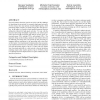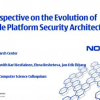CCS
2011
ACM
12 years 11 months ago
2011
ACM
XML Encryption was standardized by W3C in 2002, and is implemented in XML frameworks of major commercial and open-source organizations like Apache, redhat, IBM, and Microsoft. It ...
CCS
2011
ACM
12 years 11 months ago
2011
ACM
OneSwarm is a system for anonymous p2p file sharing in use by thousands of peers. It aims to provide Onion Routing-like privacy and BitTorrent-like performance. We demonstrate se...
CCS
2011
ACM
12 years 11 months ago
2011
ACM
Verifying that access-control systems maintain desired security properties is recognized as an important problem in security. Enterprise access-control systems have grown to prote...
CCS
2011
ACM
12 years 11 months ago
2011
ACM
Network intrusion detection systems are faced with the challenge of identifying diverse attacks, in extremely high speed networks. For this reason, they must operate at multi-Giga...
CCS
2011
ACM
12 years 11 months ago
2011
ACM
On the one hand, compilers for secure computation protocols, such as FairPlay or FairPlayMP, have significantly simplified the development of such protocols. On the other hand, ...
ISPEC
2011
Springer
13 years 2 months ago
2011
Springer
The AES block cipher has a 128-bit block length and a user key of 128, 192 or 256 bits, released by NIST for data encryption in the USA; it became an ISO international standard in ...
ISPEC
2011
Springer
13 years 2 months ago
2011
Springer
Abstract. Broadcast encryption provides a convenient method to distribute digital content to subscribers over an insecure broadcast channel. Traitor tracing is needed because some ...
CODASPY
2011
13 years 3 months ago
2011
This talk gives a personal perspective on the topic area of this new conference on data and application security and privacy, the difficult nature of the challenge we are confron...
CODASPY
2011
13 years 3 months ago
2011
CODASPY
2011
13 years 3 months ago
2011
—Progress in mobile wireless technology has resulted in the increased use of mobile devices to store and manage users’ personal schedules. Users also access popular contextbase...



